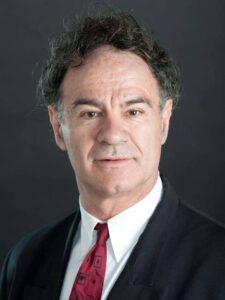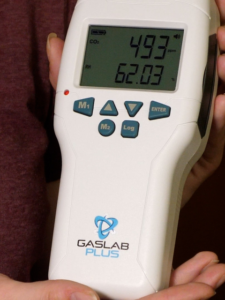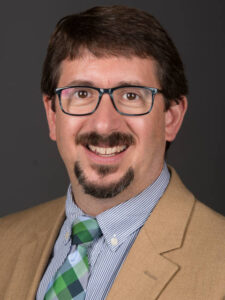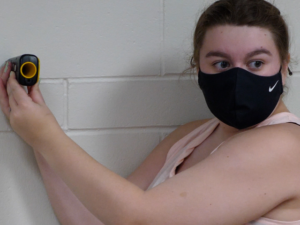When it comes to making campus safe for the start of the fall semester, the University of Wisconsin-Eau Claire is taking extra measures to improve safety — right down to the air that students, faculty and staff breathe.
As part of the overall campus plan to reduce the risk of COVID-19 transmission on campus, Grace Crickette, vice chancellor for finance and administration, has assembled a team to develop and perform air-exchange testing in campus classrooms and review classroom scheduling data to inform potential use of air purification systems where needed. This team is composed of:
-

Dr. Crispin Pierce, professor of public health and environmental studies
Dr. James Boulter, professor of chemistry and biochemistry, and public health and environmental studies.
- Dr. Crispin Pierce, professor of public health and environmental studies.
- Brian Drollinger, director of risk management.
- Arjen Van Dijk, administrative manager for administration and finance.
- Troy Terhark, director of facilities.
- Student researchers.
“Our campus is taking multiple steps to mitigate risk regarding indoor air quality,” Crickette says. “We will continue to maximize the introduction of fresh air in buildings; perform routine inspections of air handling units, exhaust fans, fume and kitchen hoods; upgrade filters to the highest MERV (minimum efficiency reporting values) rating without compromising air exchange; and augment building air handling systems with air purifiers for high-use classroom spaces.”
Team members Pierce and Boulter have enlisted 12 student researchers to conduct air-quality tests in selected rooms across campus.
“Our students are actually testing CO2 in rooms across campus to make sure we have enough ventilation to reduce the risk of COVID-19 transmission in our buildings,” Pierce says.
“It’s difficult to do,” Pierce says. “You can look at trace gases like methane, but we are using a Harvard University model to see how fast a room breaks down its CO2, removes that CO2 from the space. The CO2 is representative of vapor we all exhale, so if someone is exhaling vapor containing aerosols with the COVID-19 virus, our measurements will show how quickly a particular room ventilates and removes the virus from the air.”
The project is set up to examine a prioritized list of classrooms in older academic buildings, those rooms set to have a relatively high number of students per square foot for fall semester classes. Rooms are being tested in Hibbard, Schneider and Phillips halls, along with locations in the Nursing Building, McPhee Physical Education Center, Haas Fine Arts Center and the Human Sciences and Services building. As of Aug. 26, the team had completed testing in 16 classrooms and expect to have their results to Crickette by early next week. Plans are for testing to continue throughout the fall semester.
Pierce says test results will indicate which rooms may require added measures to improve ventilation, including options like opening doors, bringing in air purifiers and working to increase the circulation of outside air.

GasLabPlus CO2 meters are being used in this study to quickly measure and record the concentration rates of the gas.
“A red flag for us will be seeing a room that is very slow to reduce its CO2 level,” Pierce says, “We are using the World Health Organization standard to determine if a room is getting enough ventilation per student.”
Valuable hands-on learning for Blugolds
For the team of student researchers involved in the air-quality testing, this high-impact opportunity will provide a unique way to apply their classroom learning while serving the greater purpose of pandemic risk reduction.
Breanna Wiese, a senior environmental public health major from Wisconsin Dells, is finding this first collaborative student-faculty research project to be a practical and rewarding experience.

Dr. James Boulter, professor of chemistry and biochemistry, and public health and environmental studies
“It feels great knowing that this research is going to help the students here; it is fascinating because it is a situation happening right now, not something theoretical,” Wiese says. “That’s what is so great about Eau Claire. We get these opportunities to have a big impact and create a difference.”
For Brooke Jahner, also a senior ENPH major, the project is excellent preparation for what she hopes will be a career in laboratory science.
“This project is great preparation for that — any opportunity to conduct research, get results and then apply them to real life is really good experience,” said the Hortonville native.
Research based on student-initiated project
When the need arose for campus to conduct air-quality testing, this project had a significant head start with a student-initiated research project from the 2020-21 academic year.
Danielle Zahn is a third-year student from Seymour, double majoring in biology and public health. Last year she and a friend had an interest in conducting research around the COVID-19 mitigation strategies and approached faculty with an idea.
“My research partner Sidney Dame and I went to Dr. Boulter looking for an opportunity to measure ventilation rates in different rooms on campus,” Zahn says. “The importance of this was to use that data to estimate the transmission of COVID-19 on different campuses in the UW System.”

Senior Breanna Wiese uses a laser distance meter to measure room dimensions, data used to calculate room volume and determine air exchange rates.
After presenting their CO2 study at the 2021 Celebration of Excellence in Research and Creative Activity, the annual UW-Eau Claire student research event, the pair earned a second-place finish in the WySis Quick Pitch competition for their five-minute distillation of their project and its relevance for the community.
Zahn is thrilled to see the research she started now having a practical application on campus.
“First the library considered our study in deciding how to best and safely utilize spaces for the return to campus last year,” Zahn says. “It’s really a great feeling to see it taken seriously and put across campus to ensure that students are safe. We want students to be able to prioritize their education and not have to worry about their health.
“I’m excited to be able to continue this kind of work outside of UW-Eau Claire because it really does feel like I’m already contributing and already working in it. I’m glad to see the UW System schools take all the pandemic mitigation efforts seriously, like masking and social distancing. Now they are adding that vital component of ventilation.”
Written by Denise Olson
Video by Glen Mabie
